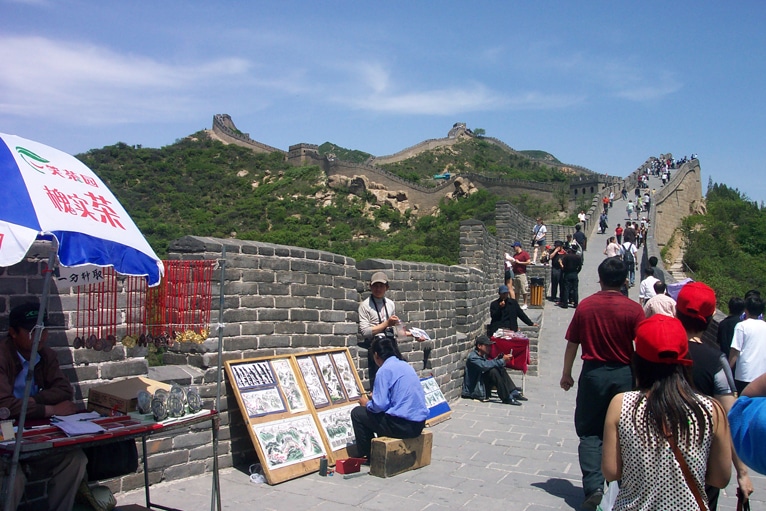Maybe you live in a place that a lot of tourists visit. What can you do to make a better connection with them and turn them into your art customers? Here are some ideas!
Artists know better than anyone that places hold meaning. That’s why they hunger for Paris, Berlin, San Francisco, Greenwich Village, and the other stops, small and large, on the International Bohemian Highway. They contrive to spend a year in London or Tokyo because those places hold special meaning. Yet most artists do not consider that the visitors who come to where they live are also hungry, also hoping to be stirred, and also looking for an experience that has nothing to do with room service breakfasts and garish souvenirs.
“Pay some new and special attention to these readily available and always changing audience members — tourists.”
Because so many artists are in survival mode, struggling to make ends meet, because they are squirreled away in their studios painting, writing or practicing their instruments, because, like everyone, they are over-busy and over-anxious, and because they tend not to think about the visitors to their community as potential audience members, they rarely connect with these fellow human beings who are themselves looking for some meaning. This is a shame, as visitors are primed and ready. It will pay artists who live in locations that attract visitors — that attract tourists, conventioneers, and people passing through — to pay some new and special attention to these readily available and always changing audience members.
How can the artists who live in a given place increase their connection to the visitors who come to that place? You live in your neighborhood, possibly far from the tourist haunts; across town, a million annual visitors pass through your city taking in the customary sites. They know that they must visit three churches, two museums and that famous shopping street — but what else? Is there a way for you to become that “what else?” Is there a way for you to make some useful contact with these visitors, contact that serves both of your ends?
First of all, who would have a say in making such contact happen? Naturally, you, the artist, would have the first say. Unless narrowing the gap that currently exists between you and the people who visit your locale interests you, nothing will happen. That opportunity falls squarely on your shoulders. Visitors, too, will have their say: if they do not show up at the event you plan, if they show up but leave immediately, or if they show up and stay but feel no connection to what you are offering, not much will have changed. This is the age-old dynamic: the artist not only must make a Herculean effort to create but must also seduce or convince her audience to pay attention to what she is offering.
There are five other constituencies who have a vested interest in seeing this gap bridged. Government officials, whose help artists will want to enlist, will also have their say, because they have the power to announce upcoming events, the power to support artists’ initiatives, and also the power to prevent the use of public spaces. Also involved are tourist industry professionals, who can trumpet the fact that artists are transforming their city into a creative hotbed or who can ignore those efforts. Also in the mix are local businessmen and women, the hotel managers, restaurant owners, and the like, who count on tourist dollars and who want to see tourism increase. Another constituency is made up of art industry professionals: gallery owners, theater directors, museum officials, publishers, and so on. Last but not least are a locale’s residents: the other people who live in your community and who may benefit or who may be harmed by the activities of visitors — and by your activities as well.
These, then, are the seven groups who have a stake in the matter: artists, visitors, government officials, tourist industry professionals, business owners, art marketplace players, and local residents. All need to stretch if the artists in a given locale are to make real contact with the tourists. But even if all the constituencies aren’t on board, you, the individual artist came make an effort. Here’s one example of such a concrete effort:
Mary, a visual artist in Toronto, explained:
“Recently a new farmer’s market formed in my neighborhood. Before finding this out, I had wanted to create an art/community event in this underutilized park to showcase some of the creativity that exists in this neighborhood. I knew that the manager, who seemed open to imaginative programming, had indicated that interactive art might be a great addition to the market, especially because of the large number of children who come with their parents. So I decided to approach him.
“At our meeting I proposed doing art workshops that tied into what the market was advocating, namely greenbelt local produce, and extending that idea into an art form that created linkage among the ideas of creativity, agriculture, community and support. It struck me that this would allow me the chance to gain more experience in facilitating workshops and working with children. I would also be putting myself out to my community as an artist whose art life included supporting local industry and who practiced sustainable art by using recycled materials and by incorporating planting as art. I proposed the workshops, they were accepted, and we’ve already begun creating market banners hand-painted on canvas. I’m not 100 percent certain yet what this means to my artwork or my business, but I feel that this is a good personality fit and a great way to gain facilitation experience.”
Making this effort can really serve you! What might you try?




